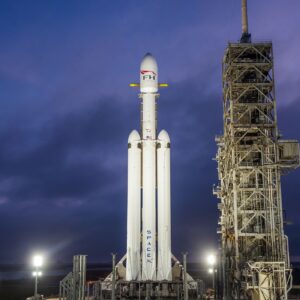
Starship Will Launch Starlab’s Commercial Space Station!
As SpaceX’s Starship gets closer to a successful orbital flight test, the next-generation launch vehicle is beginning to receive some significant contracts. Just yesterday reports came out that Voyager Space, one of the companies working on Starlab, a commercial space station, has picked SpaceX and specifically Starship as the launch vehicle.
This is big news as Voyager Space and its partners are putting a lot of trust in SpaceX both in terms of reliability and schedule. If everything goes according to plan, in just one launch Starship will utilize its significant payload storage to launch the entire station. Here I will go more in-depth into the new contract, Starship’s progress, what this means for commercial space stations, and more.
New Starship Contract

Yesterday on the 31st, Voyager Space released a full statement on the new contract and what to expect. Here they were quoted saying, “Starship, SpaceX’s fully reusable transportation system designed to carry both crew and cargo to Earth orbit, the Moon, Mars and beyond, will launch Starlab in a single mission prior to the decommissioning of the International Space Station.”
They went on to stress the importance of launching the station in just one go. For example, the Voyager Space President said “It cannot be understated, the significance of the single launch to orbit, not two-three-four launches, to close the business plan,” Not only will they launch the structure in one go, but the interior should be practically complete and fitted as well. They mention that the one launch will include a fully functional science park. No additional outfitting flights required. This is intended to accelerate accessible science, research, and manufacturing opportunities for customers.
This importance of one launch also gives insight into why they picked Starship. Put simply, the station is very big, especially when factoring in payload fairings and available launch vehicles. When launched, the space station will consist of two modules: a service module providing propulsion and energy with solar panels and a module serving as a habitat and laboratory. The main habitat portion features a diameter of 8m. To put that in perspective, most ISS modules have a 4m diameter, or half that of the Starlab Station. In addition, the entirety of Starlab will consist of “half the volume” of the ISS. In other words, Starship is set to launch a station with half the internal volume of the ISS in a single launch.
We also learned that Voyager and Airbus are targeting as early as 2028 for Starlab’s launch. This means they expect Starship to be fully operational and ready to support the launch of such a large and important structure. Even though they are planning just a single launch which increases risk in some ways, they are very confident in their choice. Voyager Chairman and CEO Dylan Taylor believes launching all of Starlab at once on Starship is “the right way to de-risk our program” he said. He also mentioned, “You then don’t have to do risky on-orbit assembly and multiple launches,”
Practically all stations in orbit right now took multiple trips and years of work to construct and piece together. The ISS took more than 40 launches for assembly and maintenance. Even modern commercial space stations such as Axiom Station are expected to consist of around 5 launches to build the station. This will also happen over a five year time period meaning Axiom may launch the first module but Starlab could very well have the first complete commercial station thanks to this contract with Starship.
The obvious concern is that while you do limit the risk of multiple launches and the assembly process, you’re putting all your eggs in one basket. If something were to go wrong on that Starship launch, practically all of the company’s progress is gone. That being said, while Starship isn’t ready to safely and confidently launch the station right now, 4 years is quite a long time, especially for SpaceX. By then, regular Starship orbital launches could already be occurring, and this contract would simply be just another launch. This is likely what Voyager Space and its partners are planning and hoping for.
Dual Progress

In preparation for this mission, both SpaceX and teams working on the Starlab station have been very busy. Right now, SpaceX is getting close to its 3rd orbital starship flight attempt. Earlier last month on January 9th, during a media brief, Jessica Jensen, vice president of customer operations and integration at SpaceX, provided some insight on the company’s plans and the next flight test. In a quote, she said, “From a hardware readiness perspective, we are targeting to be ready in January,”. To add to that, when talking about a launch license she went on to say, “We’re on track for that. We’re expecting that license to come in February. So, it’s looking like Flight 3 will occur in February.”
As we’ve seen in the past, the limiting factor on Starship launches has been related to approval rather than hardware readiness. The fact that SpaceX officials are confident about a launch license coming so soon is a good sign. Based on these comments among others, it seems that a launch toward late February is well within reach. If not then, sometime in March would be very likely. Beyond what was said during this briefing, SpaceX has also shared some positive information.
Specifically, in January, Elon provided a company update where he shared info on SpaceX’s plans, achievements, etc both for the Falcon 9 and even Starship. At one point when talking about the last Starship test flight he said, “Ironically, if it had had a payload, it would have made orbit. Because the reason that it didn’t make it to orbit is that we vented the liquid oxygen, and the liquid oxygen ultimately lead to fire and an explosion. Because we wanted to vent the liquid oxygen, and we normally wouldn’t have that liquid oxygen if we had a payload” he said. In other words, not long after stage separation when the upper stage was nearing the end of the second stage burn, SpaceX is confident that had there been a payload and no need to vent, it would have continued on without any problems.
By now, SpaceX has a very good idea of exactly what went wrong on the last flight and how to fix it. If the improvement on this 3rd flight is anything like the difference between IFT 1 and 2, it’s possible we could see Starship complete its route around the globe and attempt to reenter the atmosphere. That milestone would be very significant and become a stepping stone for even more ambitious flight profiles.
As far as physical progress, a few months ago SpaceX completed a static fire of both the booster and ship expected to attempt the next Starship flight. The booster completed its test on the actual pad while the upper stage did its test on a separate mount. Both provided promising results and also confirmed that the pad and deluge system were working properly. In the next few weeks, we can expect to hear more about the upcoming launch and whether or not they think approval is coming soon. Other than that they are nearly ready on a hardware standpoint making a launch soon realistic.
As for Starlab, the company has a busy future ahead of them now that a launch contract has been signed. In theory, the station will act as a continuously crewed, free-flying space station. They highlight that Starlab will serve a global customer base of space agencies, researchers, and companies, ensuring a continued human presence in LEO and a seamless transition of microgravity research from the International Space Station into the new commercial space station era.
“Starlab’s single-launch solution continues to demonstrate not only what is possible, but how the future of commercial space is happening now,” said Tom Ochinero, Senior Vice President of Commercial Business at SpaceX. “The SpaceX team is excited for Starship to launch Starlab to support humanity’s continued presence in low-Earth orbit on our way to making life multiplanetary” he said. In terms of progress, the Starlab team has advanced through multiple program milestones over the past year, including completion of the Systems Requirements Review, System Definition Review, Human in the Loop testing, and more. Starlab Space recently announced a teaming agreement with Northrop Grumman and plans to collaborate with the European Space Agency. Additional Starlab partners include Hilton Hotels and The Ohio State University.
In July 2023, Voyager Space and Airbus announced an agreement for a transatlantic joint venture to develop, build, and operate Starlab. In December 2021, Voyager Space was awarded a $160m public-private partnership contract from NASA to design Starlab as part of the agency’s Commercial Destinations Free Flyer program. Before then in March, NASA presented the Commercial LEO Destinations (CLD) program which aims to support the creation of private Earth-orbiting space stations in which the agency would only be one of the customers (tenant or other form of contract), with companies retaining ownership of their stations. While Starlab doesn’t have the benefit of connecting to the ISS like Axiom Space, because they are launching in one go they don’t really need it.
Conclusion
Starship was just awarded a very significant contract with Voyager Space and its partners. In 2028, the next generation launch vehicle is set to launch the entire Starlab station in a single mission. We will have to wait and see how it progresses and the impact it has on the space industry.



